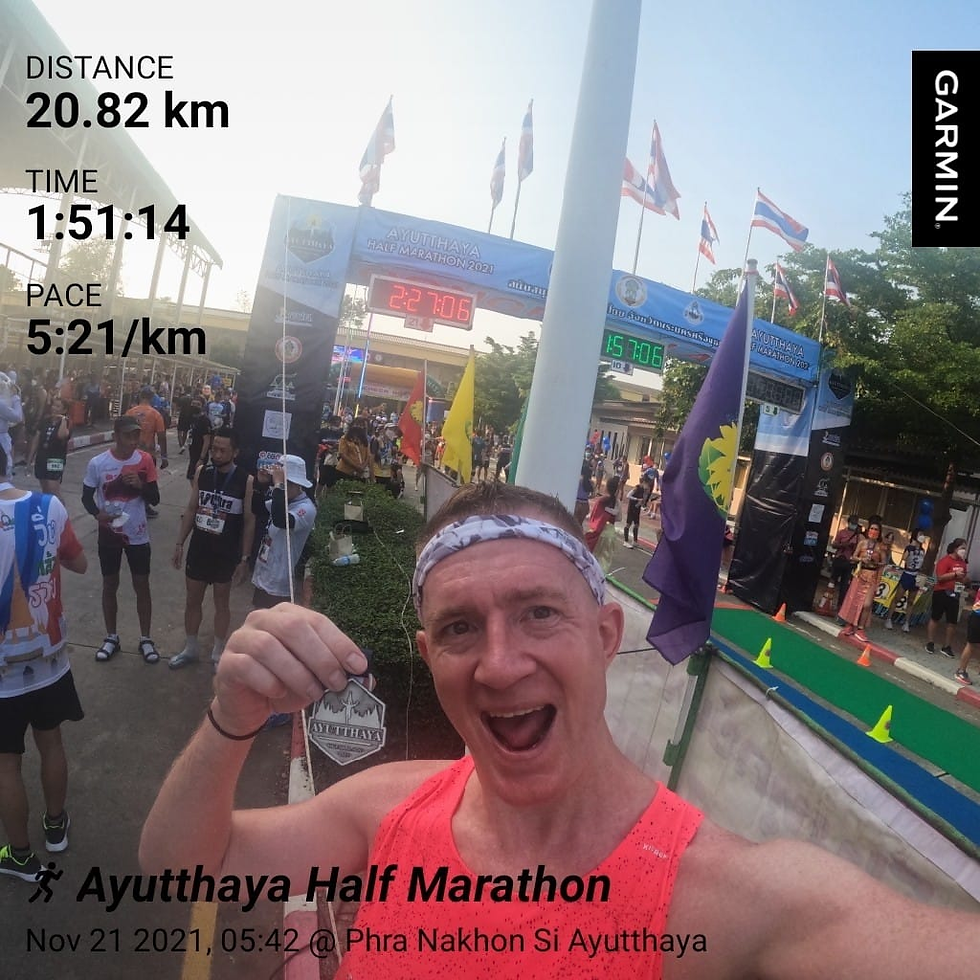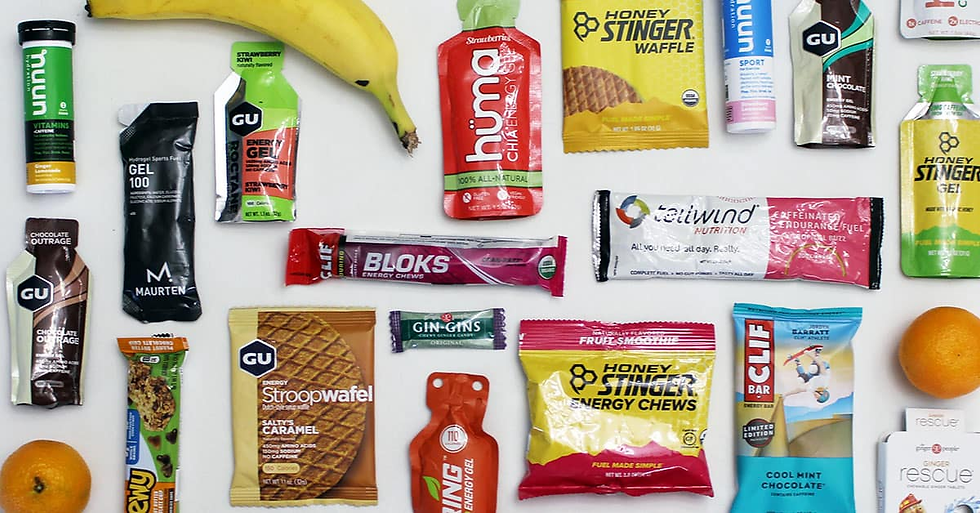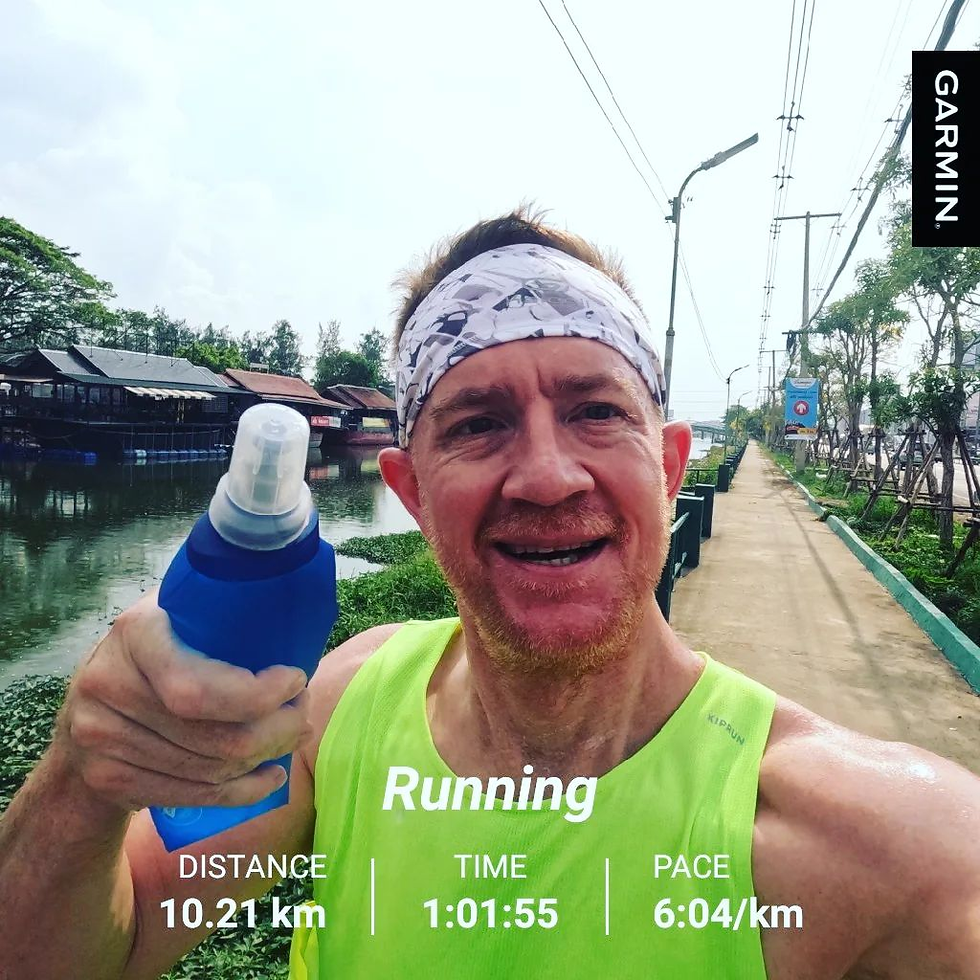Half-Marathon Training: 4 Key Success Factors!
- James G Triathlon
- Apr 21, 2022
- 5 min read

Hey there - thanks for coming to check out my "no pro" guide to half-marathon success!!
As I recently completed my first full marathon, check out my 10 things I learnt in my first marathon here, and my next race is a half-marathon in Hua Hin, Thailand - I thought it would be useful to share 4 half-marathon success factors!!
These come from some of my own experiences, along with some coaching tips from Olympic running coach Greg McMillan (he's a pro, unlike me!)
4 key success factors for a half-marathon training plan are to:
build your lower body strength and durability
increase your lactate threshold speed
plan your nutrition
pace your race (and stick to it!)
Boom! So, let's take a look at these in more detail....
1. LOWER BODY STRENGTH
Although not as important a factor as when running a marathon, it's still something to consider if you're going to be running for 90 minutes or more.
I know from my own running experience that it's not your aerobic fitness which slows you down at the end of a race (if you've nailed your pacing strategy) but muscle fatigue.

Coach Greg McMillian suggests 4 ways to get stronger, rock-solid legs!
sustainable and consistent weekly mileage
long runs
race-specific long runs
specialty leg strengthening exercises such as squats, forward and reverse lunges and glute bridges.
Each of these will increase your leg durability and will be a huge benefit for you at the back end of your race.
The consistent weekly mileage will tune your legs into running further and more often.
The long runs are going to build up leg muscle endurance
Race-specific long runs will get your legs tuned into what race pace feels like
the strength exercises are going to actually build more muscle!

Summary: If your race is going to be more than 90 minutes then make sure you have strong legs!
2. INCREASE YOUR LACTATE THRESHOLD SPEED
An obvious difference between running a marathon and a half-marathon is the speed at which you'll be running! That's not exactly ground breaking stuff, right?!

Coach McMillian describes the half-marathon as "ultimately a dance between running fast and yet not exceeding your lactate threshold and as a result, lactate threshold training becomes very, very important for half-marathon success."
I'm no pro, so I won't go into the deep science of lactate threshold here...
In very simple terms. it's the point between being able to run and maintain a good speed without the burning leg sensation and breathing like a fish out of water!
What is the Lactate Threshold?
Matt Fitzgerald, author of 80/20 endurance running suggests, "for most runners, the lactate threshold corresponds to the fastest pace that can be sustained for 30 to 60 minutes (closer to 30 minutes for less fit individuals, closer to 60 minutes for highly fit individuals). So it’s not a super-high intensity, but it’s not a low intensity either."
There are a number of ways which you can attempt to find your lactate threshold - some highly scientific and others more subjective.
Check out this article on Runners World for more detailed info about finding your own lactate threshold.
So to perform well in a half marathon we need to try and increase our lactate threshold speed to be higher - meaning that we can run faster for longer.
McMillan outlines 4 different types of lactate threshold training zone workouts which we can incorporate into our training which is hopefully going to lead to an increase in our LT speed and therefore help us to run a faster half marathon.
Lactate Threshold Zone Workouts
The table below shows the 4 different types of lactate threshold zone workouts outlined by McMillan are:
| are continuous runs at a pace that is slightly slower than your lactate threshold. These runs are especially beneficial for the half-marathon. |
| these are run bang on your lactate threshold |
| slightly faster tempo runs but you intersperse recovery jogs since you are running slightly faster than your threshold. The recovery jogs are short but because you are slightly faster than your threshold, you really trigger the body to improve your lactate threshold speed. |
| slightly faster than tempo intervals with again, short recovery intervals. Cruise intervals are especially good for runners new to stamina training or who struggle with long, continuous |
Again great benefit of lactate threshold training is that your half marathon goal race pace is likely to fall within this zone, unlike the marathon.
For example, my goal race pace for the Bang Saen Marathon was 6:19 and my goal race pace for my upcoming half marathon is 4:59
Using the McMillan pace calculator (which I think should be used as a guideline rather than gospel truth), my steady state runs are around 5:00/km, with my tempo runs at 4:36/km
Summary: Focus on lactate threshold training so you can run faster for longer. Simple!!
3. PLAN YOUR NUTRITION
Depending on your estimated finish time it may be necessary to plan your race nutrition.

As a general rule of thumb, our bodies have enough energy stored to allow us to exercise for around 80-90 minutes.
Some "no pro" science...
Your body needs carbohydrates to stay energized during exercise and most of this is stored as glycogen in the muscles and liver.
As you exercise, your body breaks down glycogen into glucose for energy.
But as soon as your glycogen stores run out you will begin to feel tired and have to put more effort in to maintain the same pace.
There are way too many fuelling strategies to cover here, but as a simple note the The American College of Sports Medicine suggest taking in an extra 30-60 grams of carbs for each hour of exercise. This could be from an energy gel, sports drink or an energy bar.
As always, use your training and long runs to test what works for you and remember the golden rule!

Don't forget your nutrition, kids!
NOTHING NEW ON RACE DAY!!
In my personal experience, I know that I can run for around 100 minutes before I begin to tire slightly - so I take 1 energy gel after 1 hour of my half-marathon to keep me juiced up until the finish!
4. PACE YOUR RACE!
For me this is an absolutely vital aspect to having a successful AND enjoyable race.
As coach McMillian says, "Go out too fast too early and you'll pay for it dearly at the end of the race."
But this is easier said than done!
You've got your pride and ego to worry about, right?
And you don't want people overtaking you from the get go. I mean, how's that gonna look to Joe Public who doesn't know your pacing it!!
At the start of the race, for sure you'll be buzzing, the adrenaline will be pumping through your veins, the crowds will be cheering and it's so easy to get caught up in the moment and go blasting off...
But have patience my friends! If it's good enough for Bruce Lee, it's good enough for me!

Chances are, come the end of the race you'll be whizzing past most of the people who went past you at the start, and some of them may even be walking which is something I've seen in my races...
So, what should you do...
Prior to the race set yourself a realistic goal
Use a pace calculator to work out your kilometre splits
Run the race and stick to your plan!!
Ideally you'd want to aim for a negative split, which means running the second half of the race quicker than the first half.
Doing so means that you will have a strong finish and be far more likely to hit your target.
Crawling across the finish line like Wendy Ingram isn't much fun and probably won't have you rushing online to sign up for your next race!!
I like to use this pace calculator which is fairly simple, and aim for 3-4% negative split.

my target for upcoming HM, 1:45:00
And here you can see the per kilometre splits which I like to use as a reference point for 5k, 10k, and 16k during the race.

For more info on running negative splits, check out ,my blog below:
You may also find this article useful about how to overcome the mental challenges you're likely to encounter at the end of a race, pretty much no matter what the distance!
FINAL THOUGHTS
I hope you find these 4 half-marathon training success factors useful - no matter what stage of your running journey you're on!
Good luck in your next race and remember...








Comments